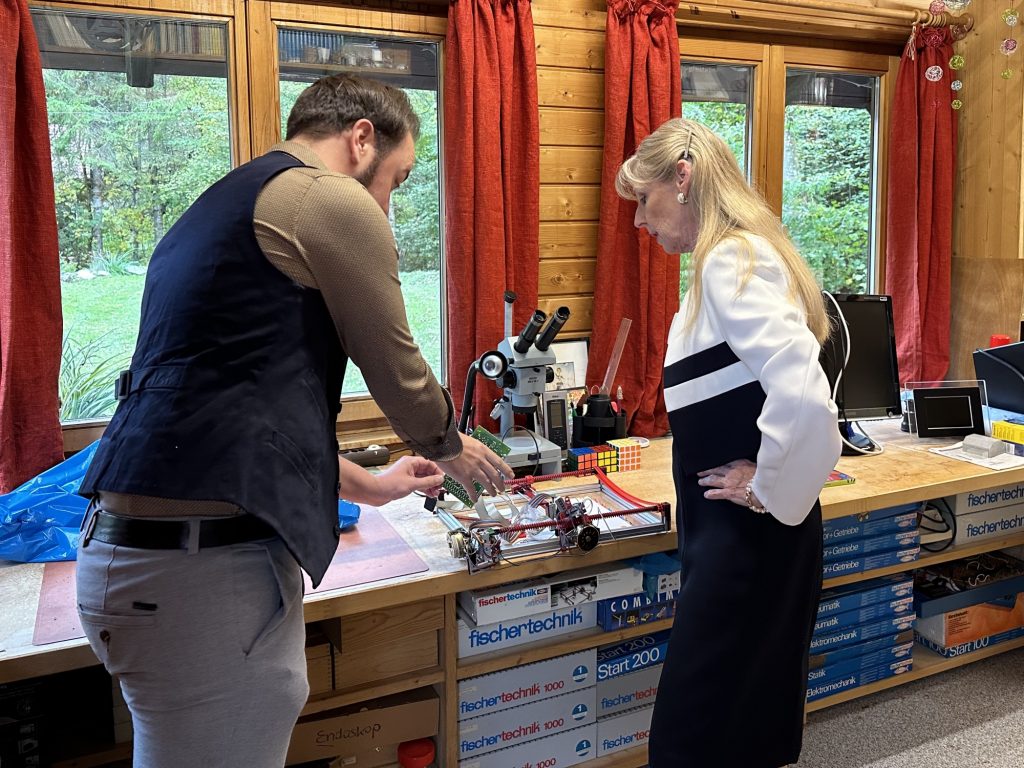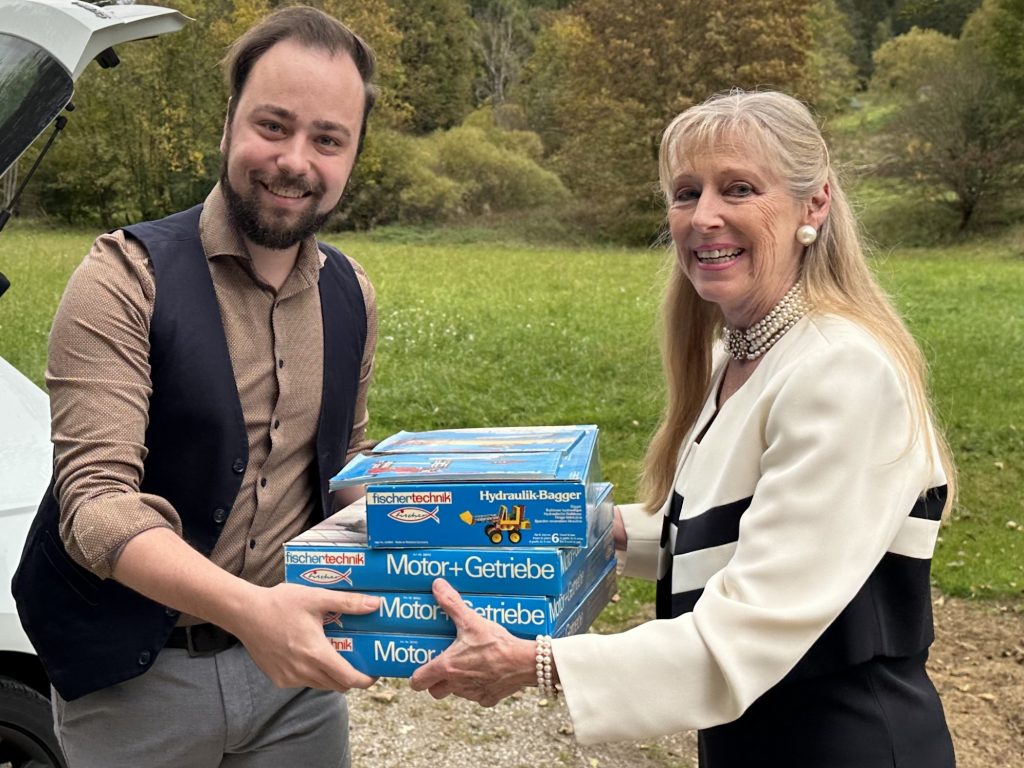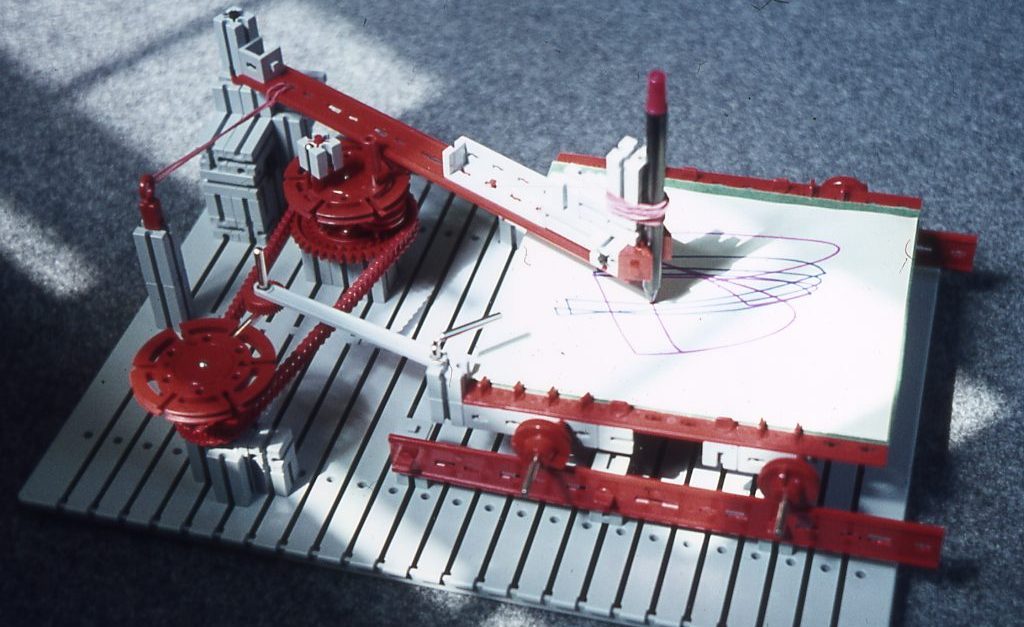fischertechnik Construction Sets from the Estate of Herbert W. Franke change Hands
Susanne Paech, founder and chairman of the art meets science – Herbert W. Franke Foundation, recently donated her private collection of fischertechnik construction sets to the renowned Rainer-Maria-Rilke-Gymnasium in Icking. The approximately twenty different kits originally belonged to her husband Herbert W. Franke, who died in 2022. He used them in the 1970s at the beginning of computer art to build, among other things, plotters of his own design for mechanical drawings. The Grammer School in the south of Munich, which currently teaches students in a humanities and a language branch as well as a science and technology branch, will use these fischertechnik kits for teaching purposes in the future. Christopher Guist, physics teacher at Ickinger Gymnasium, is delighted: “It is particularly important to experience nature for yourself for science and technology lessons at a school. Thanks to this generous donation, our pupils will be able to get more hands-on in their lessons. For Susanne Paech, it was a matter close to her heart that the collection of boxes would be put to good use. “I hope that the donation can make a small contribution to helping young people here in the neighborhood enjoy technology.” To round off the donation, the Herbert W. Franke Foundation added a new robotics kit to the collection, too.






Photos: Tanja Leikam
BACHGROUND STORY
The Inventor and the Visionary
Herbert W. Franke’s art with self-built plotters from fischertechnik
Artur Fischer is known worldwide as a great German entrepreneur. Probably everyone has held the famous Fischer dowel in their hand. But Fischer was not only an important inventor, he was also a person with a great play instinct, which he, like Herbert W. Franke, considered to be the central element of creative work. In 1964, for example, he developed a fischertechnik construction kit without any commercial background, but for pleasure – originally intended only as a Christmas present for the children of business partners. Due to the great response, Artur Fischer decided as early as 1965 to also offer this invention on the market as a construction kit system. Throughout his life, these construction kits, which were more of a niche product in the market for many years, were a special affair of the heart for Fischer.
Herbert W. Franke was immediately interested in this new, high-quality modular system and contacted Artur Fischer. From that time on, the inventor and the visionary were in constant professional exchange, with Franke immediately recommending to Fischer not only to expand the construction kits with an electronics construction kit – which was then already launched on the market in 1968 – but also to develop a construction kit for digital technology. Franke, as a publicist, science fiction author and pioneer of computer art, considered the digitization to be the most important development of post-war society. Fischer was personally very taken with this idea, but it took quite a few years before it was also supported in the company by the marketing and sales specialists.
Fischer liked to have a little personal fun with interlocutors (read also story below): the inventor, who held more than 1,000 patents to his name, gave people who presented him with good ideas a ten-penny piece. Franke received quite a few coins from Fischer over the years because he kept presenting interesting ideas. Around 1970, the two forged a plan for a publication: Franke wrote a youth book on behalf of Fischer-Werke as a present for the friends of the company. “Littlel Inventors – Great Ideas” was then published in 1972. This activity laid the first foundation stone for the book series with which fischertechnik is also active as a publisher today.


As a source of ideas, Franke repeatedly received fischertechnik boxes from Artur Fischer to try out from the end of the sixties, which Franke liked to use for various experiments. Franke, who was fascinated by the technical perfection of the system. He also investigated how he could use fischertechnik for his technoid and machine art experiments. Among other things, he used it to build several electronically controllable plotters. With them, he created colored pencil drawings of Lissajous figures or Watt’s curves, which are now part of Franke’s complete works – as are three of the plotters of the time.
Several years ago, some of these calligraphies even passed into the Museum of Modern Art in Vienna via the Bogner Collection. Franke, who knew the well-known collector of modern art from Austria well, gave him some of these works shortly after they were produced.
FROM HERBERT W. FRANKES MEMORIES
Artur Fischer, the Toy Fair in Nuremberg and a Pence for a Good Idea
Excerpt from a non-fictional manuscript in the ZKM Archive Herbert W. Franke on creativity. It was published 2016 including some examples of memories fitting to the subject. One of those tells a personal story how Franke achieved to get one of Artur Fischer’s famous pence for a very good idea in the 1970th.
For many years, I had a very pleasant collaboration with one of Germany’s most renowned inventors, namely Artur Fischer Sr., the creator of the world-famous fischer plugs and not least the ‘fischer technik’ construction kit system. On his behalf, I wrote a children’s book titled ‘Little Inventors – Big Ideas,’ and we agreed that this should also include the type of creativity that doesn’t necessarily produce something valuable in the conventional sense, such as ‘joke machines,’ ‘noise machines,’ and ‘fright machines.’ Artur Fischer is known to reward good ideas spontaneously, usually by giving a penny directly from his wallet. I remember how I acquired one: we were talking about vehicles that could be built with ‘fischer technik,’ and Mr. Fischer regretted that unfortunately, this wasn’t possible with boats, as the material of the building blocks, namely nylon, wouldn’t float well on water. “One could incorporate air-filled flotation devices to achieve the necessary buoyancy,” I suggested. “But what kind of flotation devices should they be – new building blocks would have to be developed for that.” I thought for a moment, then I proposed, “Why not use table tennis balls!” And so, at the next toy fair, a harbour facility with ‘fischer technik’ ships in real water was displayed.

